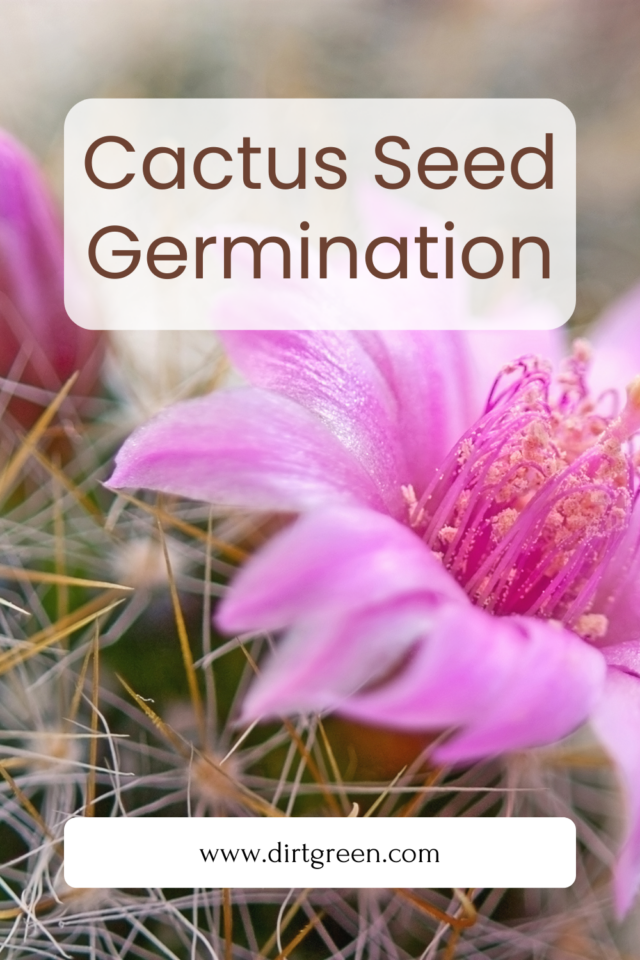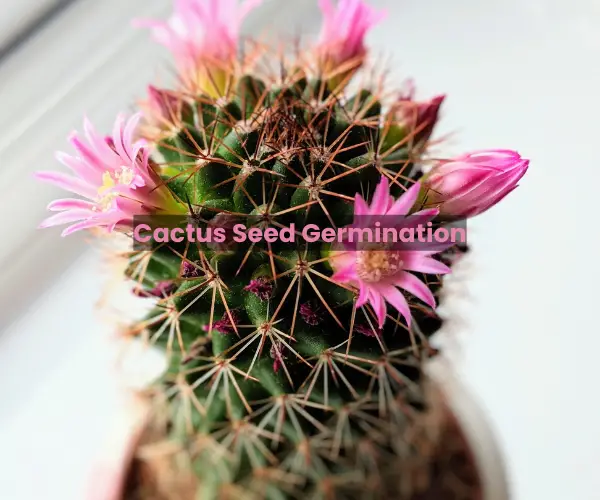For cactus enthusiasts and gardeners alike, there’s something incredibly satisfying about growing cacti from seed.
Watching the transformation from a tiny speck into a prickly succulent is like witnessing a small miracle unfold before your very eyes.
This article will bring you through the full process of propagating cacti from seed if it is something you have ever wanted to try your hand at.

Cactus Seed Germination
Cactus Seeds
Cactus seeds are remarkable little things.
Despite their diminutive size, they pack a punch of resilience and adaptability that has allowed cacti to thrive in some of the harshest environments on Earth.
Each seed contains an embryo, endosperm (a food reserve), and a hard outer coating called the testa.
The testa plays a crucial role in protecting the seed from the elements and ensuring its survival until the right conditions for germination are met.
This tough shell also helps explain why cactus seeds can remain viable for many years, sometimes even decades, when stored properly.
Preparing the Seeds
First and foremost, you’ll need to obtain fresh, high-quality cactus seeds.
Your best bet is to purchase from a reputable supplier or collect them yourself from mature cactus fruits (be careful of those spines!).
Once you have your seeds, it’s recommended to clean them by removing any pulp or debris that may be clinging to them.
This can be done by gently rubbing the seeds between your fingers or using a fine mesh strainer under running water.
Next up is the scarification process, which involves creating a small nick or abrasion in the testa.
This helps water penetrate the seed coat and kickstarts the germination process. You can use a nail file, sandpaper, or even a sharp knife to carefully score the testa without damaging the inner components of the seed.
Soaking the Seeds
After scarification, it’s time to give your cactus seeds a good soaking. This helps rehydrate the embryo and endosperm, preparing them for the next phase of growth.
There are a few different soaking methods to choose from:
1). Water Soak: Simply place the seeds in a container of room-temperature water and let them soak for 12-24 hours.
2). Acid Soak: Some growers swear by soaking cactus seeds in a diluted acid solution, such as lemon juice or vinegar, for 24 hours. The mild acid is thought to further weaken the seed coat.
3). Gibberellic Acid Soak: For particularly stubborn seeds, you can try soaking them in a gibberellic acid solution, which is a plant hormone that promotes germination.
Whichever method you choose, be sure to drain and rinse the seeds thoroughly before planting.
Preparing the Growing Medium
While cacti are known for their hardiness, their seedlings require a bit of extra care and attention. The growing medium you choose will play a crucial role in helping those delicate sprouts establish themselves.
A well-draining soil mix is essential, as cacti seedlings are highly susceptible to dampening off (a fungal disease that can rot the stem and kill the plant). A blend of potting soil, coarse sand or perlite, and a touch of charcoal or bark is a good starting point.
Sterilizing the growing medium is also recommended to eliminate any potential pathogens or pests that could harm your seedlings. You can do this by baking the soil mix in the oven or microwaving it in short bursts.
Planting the Seeds
Once your seeds are soaked and your growing medium is prepped, it’s time to get planting! Here are the steps to follow:
1). Fill a clean container (seed trays, pots, or even recycled containers like milk cartons work well) with your sterile soil mix, leaving about an inch of space at the top.
2). Gently press the surface of the soil to create a firm, level planting area.
3). Distribute the soaked seeds evenly across the surface, spacing them out as much as possible to give each seedling room to grow.
4). Cover the seeds with a thin layer of soil, no more than 1/4 inch deep.
5). Mist the soil with a spray bottle to lightly moisten it.
6). Cover the container with a clear plastic lid or wrap to create a humidity dome. This will help maintain consistent moisture levels during the germination process.
Cactus seeds require warmth to germinate, so you’ll want to place your containers in a spot that stays between 70-85°F (21-29°C). A heated propagation mat can be useful for maintaining a constant temperature.
Be patient – depending on the species, it can take anywhere from a few days to several months for those first sprouts to appear!
Caring for Cactus Seedlings
Once your seeds have germinated and those tiny seedlings start to emerge, it’s time to shift your focus to their ongoing care and development.
Light
Cactus seedlings need plenty of bright light to grow strong and healthy. Place them in a sunny window or under grow lights, gradually increasing their light exposure as they mature.
Water
Watering is a delicate balance with cactus seedlings. Too much moisture can lead to rot, while too little will stunt their growth. A good rule of thumb is to water from the bottom, allowing the soil to absorb moisture slowly, and letting the top inch of soil dry out between waterings.
Air Circulation
Good air flow is important to prevent fungal diseases and promote strong, stocky growth. Consider using a small fan or opening a window to create gentle breezes around your seedlings.
Transplanting
As your seedlings grow, you’ll need to transplant them into larger containers with a well-draining cactus/succulent soil mix. Be very gentle when handling the delicate seedlings, and take care not to damage their tender roots.
Fertilizing
Once your cactus seedlings have developed their first set of true spines (usually after a few months), you can begin feeding them with a diluted cactus fertilizer every 4-6 weeks during the growing season.
Patience and Perseverance
Growing cacti from seed is a labor of love that requires patience and perseverance. It can take years for some species to reach a sizeable, mature form.
But for the dedicated cactus enthusiast, watching those prickly little seedlings transform into magnificent, blooming specimens is an incredibly rewarding experience.
Thus, gather your cactus seeds, put on some gloves, and get ready to set off on a propagation and growth expedition.
You may create a flourishing cactus garden that you can genuinely call your own with the correct methods and a little tender loving care.




